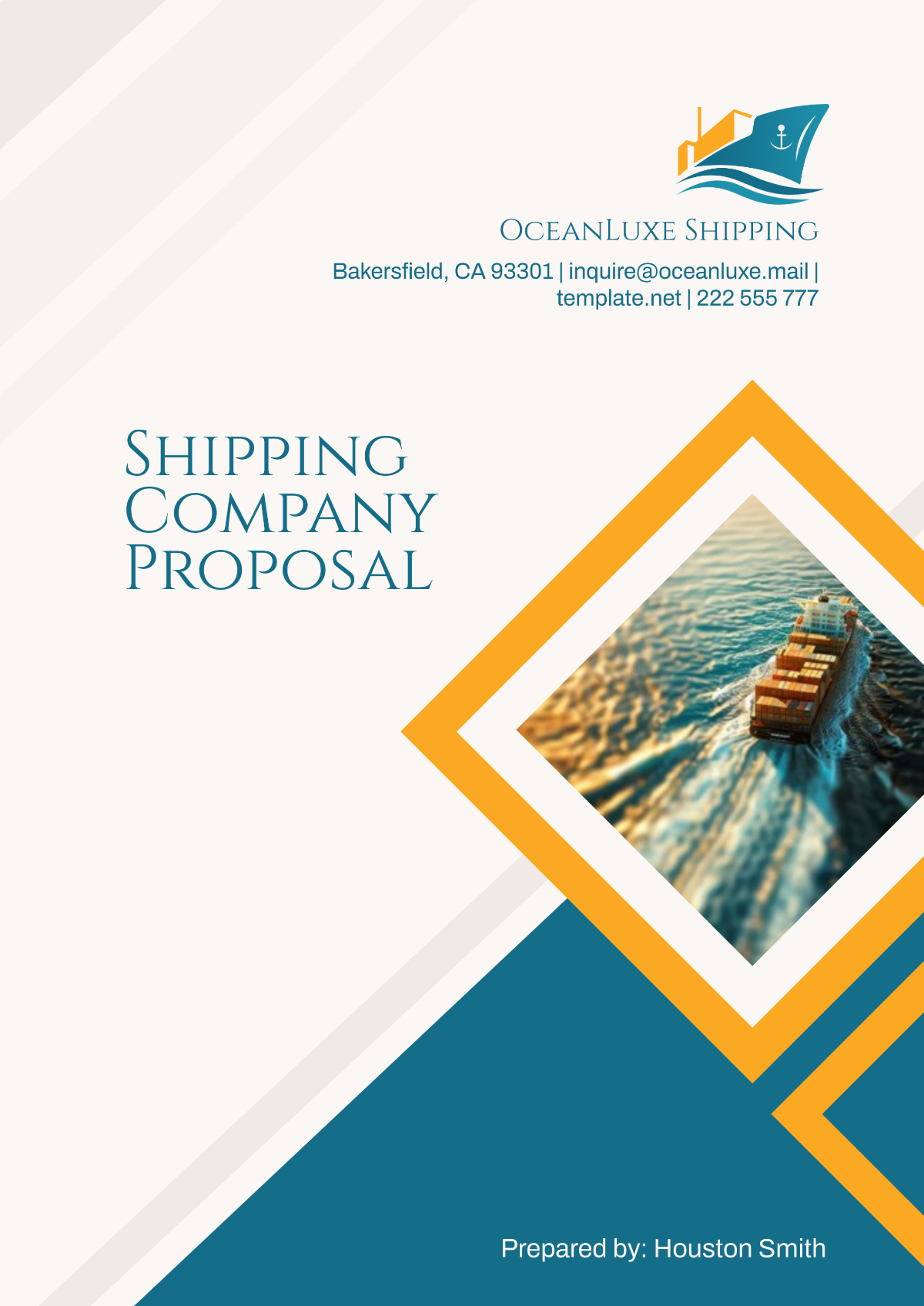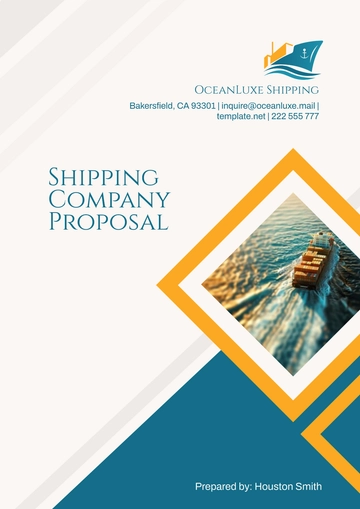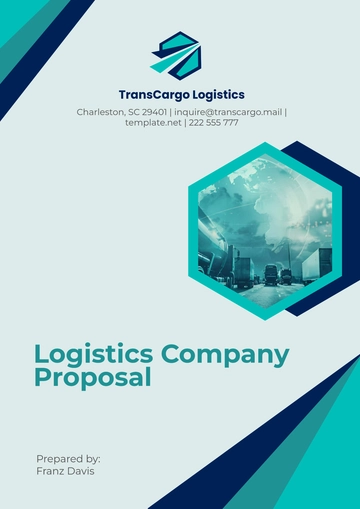Free Shipping Company Proposal

1. Executive Summary
1.1 Company Overview
[Your Company Name] is poised to become a leader in the shipping industry by integrating cutting-edge technology with sustainable practices. We are committed to revolutionizing the way global shipping operates by combining AI-powered logistics, automated systems, and eco-friendly fleet solutions. As international shipping demands continue to grow, [Your Company Name] stands ready to provide cost-effective, reliable, and environmentally conscious services to businesses worldwide. Our operations will span key international routes, serving a diverse client base while actively working to reduce the carbon footprint of the shipping industry.
1.2 Mission Statement
Our mission is to offer innovative and sustainable shipping solutions that deliver high efficiency, cost-effectiveness, and unmatched customer satisfaction. We aim to provide businesses with secure and timely shipping options, leveraging state-of-the-art technology and practices that reduce environmental impact while enhancing the value of the supply chain. Through our services, we aspire to lead the transformation of the shipping sector, creating a cleaner, greener, and more connected global marketplace.
1.3 Key Objectives
Achieve Carbon Neutrality: By 2055, we will achieve carbon neutrality through the transition to hybrid and fully electric ships. We are committed to reducing the carbon footprint of our operations to meet global climate targets.
Expand Global Reach: Over the next decade, we aim to expand our service to over 100 countries, ensuring that businesses worldwide can rely on us for fast, efficient, and sustainable shipping.
Maximize Automation: [Your Company Name] will leverage automation technologies to improve operational efficiency. By 2060, we aim to have over [80%] of our logistics process automated, reducing human error and improving reliability.
Achieve Financial Growth: We project an annual revenue growth of [8%] from 2050 to 2060, focusing on increasing market share, reducing costs, and offering value-added services.
2. Market Analysis
2.1 Industry Overview
The global shipping industry is undergoing significant changes as demand for sustainable solutions, digital transformation, and operational efficiency continues to rise. The market is projected to grow at a compound annual growth rate (CAGR) of [4.5%] between 2050 and 2060, driven by the expansion of international trade, the growing demand for e-commerce, and the increasing adoption of digital technologies. With the rising focus on reducing the carbon footprint, there is a growing emphasis on electric and hybrid ships, as well as green logistics solutions. Regulatory frameworks are becoming more stringent, with carbon emissions regulations tightening worldwide, especially in key regions like Europe and North America.
2.2 Target Markets
[Your Company Name] will focus on high-growth regions that are integral to global trade. These include:
Asia-Pacific: The region, home to major shipping ports in China, Japan, and Southeast Asia, is one of the fastest-growing markets. We plan to focus on expanding operations here, offering cost-effective, eco-friendly shipping solutions to manufacturers and e-commerce businesses.
Europe: With the European Union's emphasis on reducing emissions, we will target green shipping solutions to comply with regulatory demands and attract businesses that prioritize sustainability.
North America: The US and Canada are crucial hubs for global trade, with large e-commerce markets demanding fast, reliable, and cost-effective shipping services.
2.3 Competitive Landscape
The shipping industry is highly competitive, with major global players dominating the market. Companies like Maersk and CMA CGM are leading the charge in digital shipping solutions, while emerging players focus on niche markets or sustainability. [Your Company Name] will differentiate itself by combining automation, sustainability, and cutting-edge technology to offer more affordable and environmentally conscious solutions. By adopting advanced logistics software, automation, and green technologies, we aim to provide services that not only meet but exceed the expectations of our customers.
2.4 SWOT Analysis
Strengths | Weaknesses |
|---|---|
Strong focus on sustainability | High initial capital investment required |
Investment in advanced technology | Limited brand recognition in the early stages |
Scalable solutions with automated processes | Regulatory hurdles and compliance risks |
Opportunities | Threats |
|---|---|
Increasing demand for eco-friendly shipping solutions | Intense global competition from established players |
Growing e-commerce and international trade | Economic downturns that could impact global trade |
New technological advancements in shipping efficiency | Regulatory changes impacting operations |
3. Services Offered
3.1 Freight Shipping
[Your Company Name] provides comprehensive freight shipping services tailored to meet the needs of diverse industries. Our offerings include:
International Shipping Services: Transporting large-scale cargo to and from major ports across the globe. We offer both full-container-load (FCL) and less-than-container-load (LCL) options to accommodate a range of business sizes.
Domestic Shipping Services: We offer domestic freight solutions that ensure rapid delivery across regional markets. Businesses looking for fast shipping within the same country can rely on our service to ensure timely arrivals.
Specialized Cargo Shipping: Whether it’s fragile goods, hazardous materials, or oversized shipments, we have specialized cargo handling capabilities to ensure safe and efficient transport.
3.2 Express Shipping
Our express shipping services are designed for businesses that need rapid delivery of time-sensitive shipments. With options for 24-hour or 48-hour delivery, we ensure that high-priority goods such as medical supplies, fresh food products, and e-commerce parcels reach their destinations swiftly and securely.
3.3 Sustainable Shipping Solutions
[Your Company Name] is committed to environmentally sustainable practices across all our services:
Hybrid Fleet: Our fleet includes hybrid cargo ships that utilize a combination of traditional fuel and electric power, significantly reducing emissions. These ships are capable of completing long-haul journeys while minimizing environmental impact.
Green Certifications: We are dedicated to obtaining environmental certifications that reflect our commitment to sustainable operations. These include ISO 14001 and LEED certification for our facilities and operations.
3.4 Value-Added Services
To enhance our shipping solutions, we provide additional services that cater to the specific needs of our customers:
Real-Time Tracking: Our AI-powered logistics software allows customers to track their shipments in real-time, providing full visibility and reducing uncertainty.
Insurance Packages: We offer a range of insurance packages, ensuring the protection of cargo against damage, loss, or theft during transit.
Warehousing and Fulfillment: Our efficient storage solutions allow businesses to store goods safely and handle order fulfillment seamlessly.
4. Operations Plan
4.1 Fleet Composition and Maintenance
[Your Company Name] will maintain a modern fleet consisting of various types of vessels suited for different shipping needs. The fleet will be regularly maintained to ensure compliance with environmental standards, optimize fuel efficiency, and ensure timely deliveries.
Ship Type | Quantity | Energy Source | Purpose |
|---|---|---|---|
Electric Cargo Ships | 50 | Electric | Short-haul, eco-friendly routes |
Hybrid Long-Haul Ships | 80 | Hybrid | International freight routes |
Automated Drones | 100 | Electric | Express parcel delivery |
Regular maintenance schedules will be established for all vessels. Preventive maintenance programs will ensure all ships are in peak condition, minimizing disruptions to service.
4.2 Technological Infrastructure
The backbone of our operations will be the use of advanced technology to enhance efficiency and streamline logistics. This includes:
AI-Driven Logistics Software: Our software will optimize routing, reducing fuel costs by as much as [30%] by minimizing detours and using the most fuel-efficient paths.
IoT-Enabled Fleet Management: IoT devices embedded in the fleet will provide real-time data on fleet conditions, helping predict maintenance needs and improve fleet management.
4.3 Human Resources
Our human resources strategy is designed to create a balance between advanced technology and skilled personnel. While [Your Company Name] will automate [80%] of its logistics processes by 2060, human expertise will remain essential for overseeing operations and handling complex decision-making processes. The company will recruit individuals with experience in logistics, technology, and environmental sustainability to ensure all aspects of our services are handled efficiently.
5. Financial Plan
5.1 Revenue Projections
The global shipping market is expected to experience robust growth through 2060. [Your Company Name] forecasts that its revenue will grow significantly as demand for more sustainable and efficient shipping solutions rises. The expansion of e-commerce, cross-border trade, and the increasing adoption of green shipping technologies will play a significant role in driving our revenue streams. Our revenue projections are built on a combination of expected market growth, operational efficiency improvements, and the adoption of automated and eco-friendly technologies.
We estimate our revenue from different segments to be distributed as follows:
Year | Freight Shipping Revenue | Express Shipping Revenue | Sustainable Shipping Revenue | Total Revenue |
|---|---|---|---|---|
2050 | $200M | $100M | $50M | $350M |
2051 | $210M | $110M | $60M | $380M |
2052 | $225M | $125M | $70M | $420M |
2055 | $300M | $150M | $100M | $550M |
2060 | $450M | $250M | $200M | $900M |
As shown in the table, revenue is expected to grow steadily as more industries embrace digital and eco-friendly shipping solutions. The increased adoption of hybrid and electric vessels will also boost our sustainability offerings, generating a substantial portion of our revenue by 2060. Furthermore, our express shipping services will cater to the growing need for fast and reliable delivery, especially in e-commerce.
5.2 Cost Structure
[Your Company Name]'s cost structure will reflect a combination of fixed and variable costs, primarily driven by fleet management, technology infrastructure, labor, and operational expenses. One of our key strategies is to minimize costs related to fuel and ship maintenance by transitioning to a fleet of hybrid and electric vessels. In doing so, we anticipate reducing fuel-related costs over time, particularly as the energy grid becomes greener and more cost-effective.
The cost structure in the coming years will also reflect investments in technology to maintain a competitive edge. We plan to invest heavily in artificial intelligence (AI) and Internet of Things (IoT) technologies, which will help optimize routes, manage logistics, and provide real-time data on fleet and cargo.
Expense Type | Yearly Cost 2050 | Yearly Cost 2055 | Yearly Cost 2060 |
|---|---|---|---|
Fleet Maintenance | $30M | $40M | $45M |
Fuel (Hybrid Ships) | $100M | $80M | $50M |
Technology Investment | $20M | $30M | $40M |
Labor Costs | $50M | $60M | $70M |
Insurance and Claims | $10M | $12M | $15M |
Marketing and Customer Acquisition | $15M | $18M | $20M |
Miscellaneous Operating Expenses | $5M | $7M | $10M |
As shown in the table, fuel and fleet maintenance costs will decrease as we transition to more sustainable ships. Technology investments will also increase, reflecting our dedication to automation and AI in logistics. Labor costs are expected to rise due to workforce expansion, but these will be offset by productivity gains from automation. Insurance and claims costs will gradually increase as our shipping volume grows.
5.3 Profitability and Break-even Analysis
To determine the profitability of our business model, we have calculated the projected break-even point. Based on our cost and revenue projections, we expect to reach our break-even point within 6 years of operation, with significant profitability thereafter. Below is a breakdown of the break-even analysis.
Year | Cumulative Revenue | Cumulative Costs | Net Profit (Loss) | Cumulative Profit (Loss) |
|---|---|---|---|---|
2050 | $350M | $300M | $50M | $50M |
2051 | $380M | $320M | $60M | $110M |
2052 | $420M | $330M | $90M | $200M |
2055 | $550M | $370M | $180M | $380M |
2060 | $900M | $500M | $400M | $780M |
By 2055, we expect to generate approximately [$180M] in profit annually, with profits continuing to grow as our business matures and our market share increases. The strategic investments in automation, fleet modernization, and eco-friendly technology will help us maintain high profit margins while minimizing operational costs.
6. Risk Management
6.1 Regulatory Risks
The shipping industry is subject to a complex set of international, national, and regional regulations aimed at controlling emissions, ensuring safety, and preventing environmental damage. Given the increasing pressure to address climate change, regulatory risks are a significant concern. There are ongoing initiatives globally to enforce stricter carbon emissions standards for the shipping sector, with several countries planning to impose carbon taxes and cap-and-trade systems on the industry by 2050. Additionally, there are stringent regulations related to the handling of hazardous materials, maritime safety standards, and employee welfare.
To mitigate these risks, [Your Company Name] will invest in:
Compliance Monitoring Systems: We will deploy sophisticated compliance software that tracks global regulations and ensures our fleet and operations are always up to date with the latest legal requirements.
Sustainability Practices: Our shift towards hybrid and electric vessels will not only help us reduce fuel consumption but will also align with international environmental regulations, giving us a competitive advantage in regions with strict emissions standards.
Legal Consultation: We will work closely with maritime legal experts to ensure compliance with all international shipping laws and to avoid penalties related to non-compliance.
6.2 Operational Risks
Operational risks stem from various factors such as fleet maintenance issues, unforeseen technological failures, natural disasters, and labor disputes. With the scale of operations that [Your Company Name] is anticipating, operational disruptions could significantly affect our shipping schedules and customer satisfaction. To mitigate these risks:
Fleet Maintenance Programs: We will implement robust preventive maintenance protocols and ensure timely inspections of all vessels. The deployment of AI-powered diagnostic tools will allow us to detect any issues before they escalate.
Redundancy Systems: In case of ship failure or delays, we will have contingency plans in place, including rerouting shipments through alternative shipping routes or partners.
Supply Chain Diversification: We will diversify our supply chain to prevent operational bottlenecks. In the event of a disruption, we can quickly source alternative suppliers and transportation providers to meet client demands.
6.3 Market Risks
Economic downturns, shifts in global trade patterns, and changing consumer behaviors represent potential market risks for the shipping industry. For example, a global recession could lead to a slowdown in international trade, affecting demand for shipping services. Similarly, disruptions in global supply chains due to geopolitical instability or natural disasters could result in a significant reduction in cargo volume.
To mitigate these risks:
Diversification of Client Base: We will focus on serving a broad range of industries, from e-commerce to pharmaceuticals and automotive manufacturing. This diversification will protect us from downturns in any specific industry.
Flexible Pricing Models: We will implement dynamic pricing strategies, adjusting rates based on demand fluctuations. This flexibility will help us remain competitive during periods of reduced shipping volumes.
Geopolitical Risk Monitoring: Our team will monitor geopolitical developments closely and be prepared to adjust our routes and operations accordingly to minimize disruption.
6.4 Financial Risks
Fluctuations in currency exchange rates, fuel costs, and interest rates can pose financial risks to a global shipping company like [Your Company Name]. As fuel is a significant expense in shipping operations, fluctuations in oil prices can affect profitability. Additionally, changes in currency exchange rates can impact the cost of goods transported across different regions.
To mitigate these financial risks:
Fuel Hedging Strategies: We will engage in fuel hedging contracts to lock in favorable fuel prices for long periods, reducing exposure to volatile fuel costs.
Currency Risk Management: We will use financial instruments such as forward contracts and currency options to minimize the risks associated with currency fluctuations.
Financial Forecasting: Our financial team will conduct regular risk assessments and implement forecasting models to predict and prepare for potential financial risks.
7. Conclusion
7.1 Summary of [Your Company Name]'s Vision
In summary, [Your Company Name] is primed to redefine the shipping industry by integrating automation, eco-friendly technologies, and innovative business strategies. Our focus on sustainability, operational efficiency, and global expansion will enable us to capture significant market share while meeting the demands of a rapidly evolving industry. We believe that the future of shipping lies in sustainable practices, and we are committed to leading this transformation by 2050 and beyond.
Our financial strategy, focused on long-term growth, profitability, and operational efficiency, is designed to ensure success in an increasingly competitive global market. By minimizing risks, ensuring compliance with regulations, and expanding into new markets, we will position ourselves to thrive in the next few decades.
7.2 Call to Action
We invite stakeholders, investors, and partners to join us on this exciting journey. Together, we can revolutionize the shipping industry, reduce its carbon footprint, and build a sustainable future. We are confident that our long-term vision will lead to substantial returns on investment and help make [Your Company Name] a global leader in eco-friendly shipping solutions.
- 100% Customizable, free editor
- Access 1 Million+ Templates, photo’s & graphics
- Download or share as a template
- Click and replace photos, graphics, text, backgrounds
- Resize, crop, AI write & more
- Access advanced editor
Present your logistics services professionally with the Shipping Company Proposal Template from Template.net. This editable and customizable template includes key proposal sections for services, pricing, and timelines. Easily adjust it with our Ai Editor Tool to make a persuasive, polished proposal for potential clients.
You may also like
- Business Proposal
- Research Proposal
- Proposal Request
- Project Proposal
- Grant Proposal
- Photography Proposal
- Job Proposal
- Budget Proposal
- Marketing Proposal
- Branding Proposal
- Advertising Proposal
- Sales Proposal
- Startup Proposal
- Event Proposal
- Creative Proposal
- Restaurant Proposal
- Blank Proposal
- One Page Proposal
- Proposal Report
- IT Proposal
- Non Profit Proposal
- Training Proposal
- Construction Proposal
- School Proposal
- Cleaning Proposal
- Contract Proposal
- HR Proposal
- Travel Agency Proposal
- Small Business Proposal
- Investment Proposal
- Bid Proposal
- Retail Business Proposal
- Sponsorship Proposal
- Academic Proposal
- Partnership Proposal
- Work Proposal
- Agency Proposal
- University Proposal
- Accounting Proposal
- Real Estate Proposal
- Hotel Proposal
- Product Proposal
- Advertising Agency Proposal
- Development Proposal
- Loan Proposal
- Website Proposal
- Nursing Home Proposal
- Financial Proposal
- Salon Proposal
- Freelancer Proposal
- Funding Proposal
- Work from Home Proposal
- Company Proposal
- Consulting Proposal
- Educational Proposal
- Construction Bid Proposal
- Interior Design Proposal
- New Product Proposal
- Sports Proposal
- Corporate Proposal
- Food Proposal
- Property Proposal
- Maintenance Proposal
- Purchase Proposal
- Rental Proposal
- Recruitment Proposal
- Social Media Proposal
- Travel Proposal
- Trip Proposal
- Software Proposal
- Conference Proposal
- Graphic Design Proposal
- Law Firm Proposal
- Medical Proposal
- Music Proposal
- Pricing Proposal
- SEO Proposal
- Strategy Proposal
- Technical Proposal
- Coaching Proposal
- Ecommerce Proposal
- Fundraising Proposal
- Landscaping Proposal
- Charity Proposal
- Contractor Proposal
- Exhibition Proposal
- Art Proposal
- Mobile Proposal
- Equipment Proposal
- Student Proposal
- Engineering Proposal
- Business Proposal



